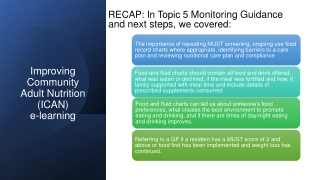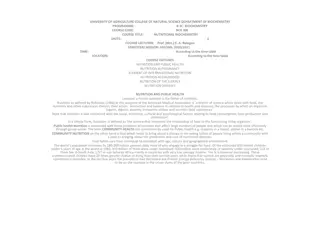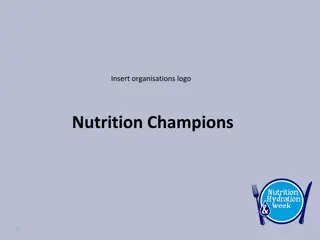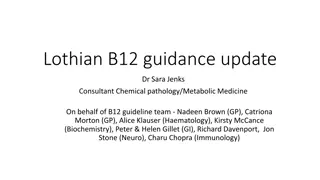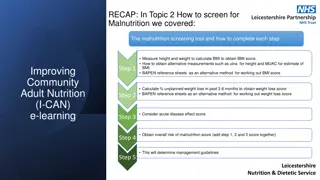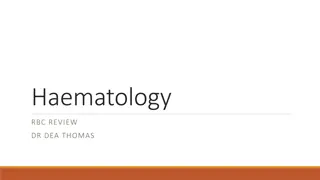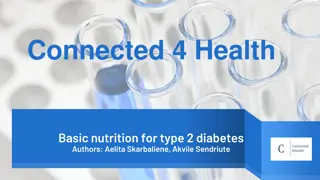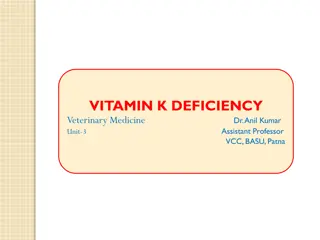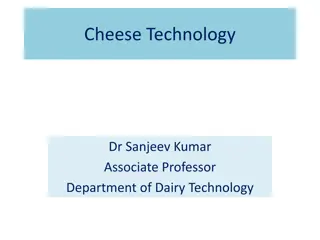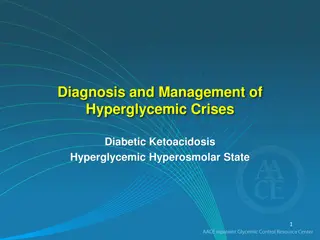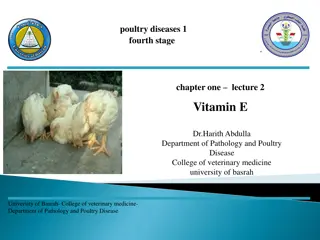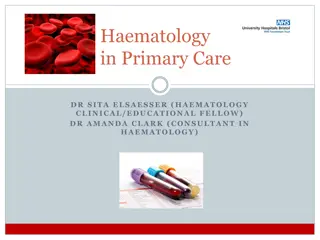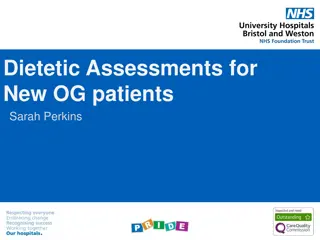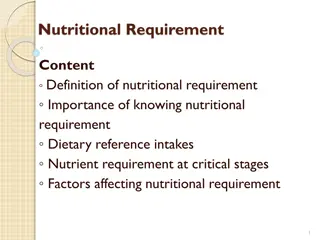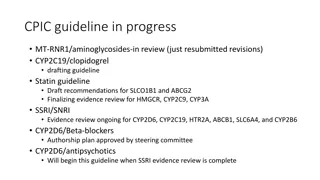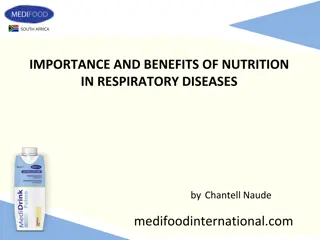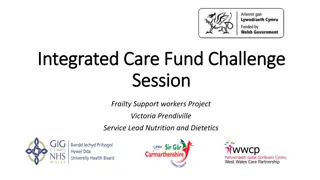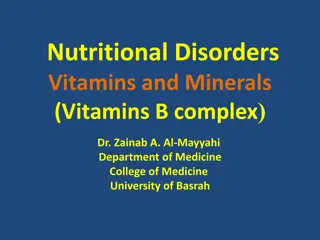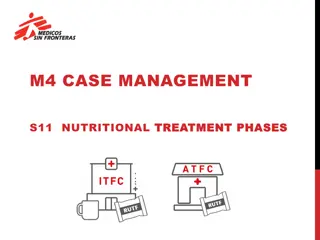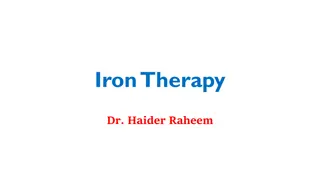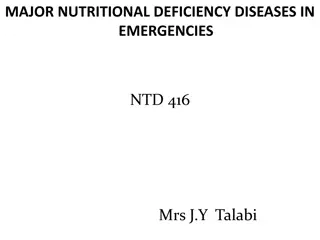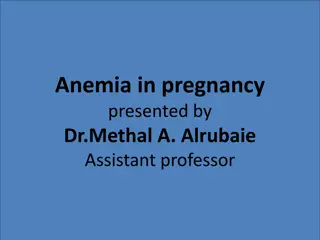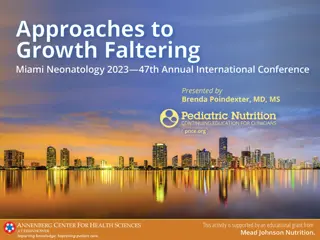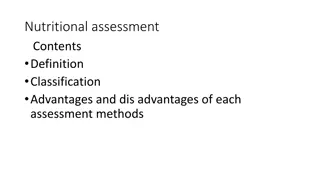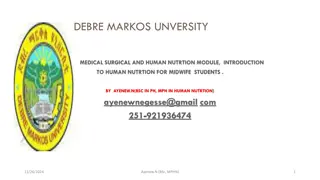Vitamin A Deficiency (Hypovitaminosis A)
Learn about the causes, symptoms, and effects of Vitamin A deficiency, including night blindness, corneal keratinization, and impaired immune function. Explore the epidemiology and pathogenesis of this condition.
0 views • 13 slides
Importance of Monitoring Guidance in Nutritional Care
This recap covers the significance of regular screening, using food record charts, identifying barriers to care plans, and reviewing nutritional compliance. It emphasizes the ICAN e-learning module and the key factors influencing nutritional care. The content highlights the importance of adequate fl
0 views • 16 slides
Efficacy and Safety of Ferric Carboxymaltose for Heart Failure with Iron Deficiency
Iron deficiency is prevalent in heart failure patients with reduced ejection fraction and is linked to poor outcomes. The HEART-FID trial investigates the impact of intravenous ferric carboxymaltose (FCM) on all-cause mortality, heart failure hospitalizations, and exercise capacity in chronic HFrEF
1 views • 17 slides
Understanding Mental Deficiency: Causes and Classifications
Mental deficiency, also known as intellectual disability, is characterized by significantly below-average intellectual functioning before the age of 18, along with limitations in adaptive behaviors. It is measured using standardized IQ tests, with classifications ranging from profound to mild. Two m
3 views • 65 slides
Overview of Nutritional Diseases and Disorders
Nutritional diseases arise from imbalances between the body's nutrient and energy requirements and their supply. Nutritional deficiencies can lead to clinical diseases, while excessive intake can result in diseases of affluence. Common nutritional disorders include low birth weight, PEM, obesity, go
4 views • 6 slides
Understanding Nutritional Biochemistry: A Comprehensive Overview of Nutrition and Public Health
Nutrition, as defined by Robinson, explores the relationship between food and the human body's functioning. This course delves into key topics such as nutrition in pregnancy, childhood, and the elderly, as well as nutrition-related diseases. It emphasizes the importance of public health nutrition in
1 views • 7 slides
Understanding Cholestasis: Etiology, Clinical Manifestations, and Complications
Cholestasis is characterized by reduced bile flow and elevated direct bilirubin. It is critical to differentiate it from neonatal jaundice. In conditions like biliary atresia and 1-antitrypsin deficiency, early diagnosis and intervention are crucial to prevent liver failure. Clinical manifestations
5 views • 14 slides
Nutrition Champions: Improving Nutritional Care in Health and Social Settings
Nutrition Champions play a vital role in promoting food and drink as essential components of care packages in various settings. Their goal is to enhance nutritional and hydration care, share best practices, facilitate behavior change, and improve access to healthy food and fluids. The content discus
1 views • 21 slides
Managing Nutritional and Metabolic Diseases in Zoo and Wild Animals
The prevention, control, and treatment of nutritional and metabolic diseases in zoo and wild animals are essential for maintaining their health. These diseases, such as rickets, osteoporosis, osteomalacia, and fibrous osteodystrophy, can result from imbalances in dietary nutrients and metabolic dera
0 views • 10 slides
Update on B12 Deficiency Guidance by Lothian Health Services
Vitamin B12 deficiency is a complex condition with various manifestations, including neurological symptoms. The updated guidelines address key areas such as neuro symptoms, coeliac disease, and transitioning from intramuscular to oral treatment. Testing indications and approaches for pernicious anae
0 views • 12 slides
Understanding Malnutrition Screening and Nutritional Care Planning
In this overview, discover the process of screening for malnutrition, including calculating BMI, assessing weight loss, and determining overall malnutrition risk. Explore how to create a nutritional care plan based on the MUST score and set appropriate nutritional aims for patients.
0 views • 12 slides
Enhancing Nutritional Security in SADC Communities through Sugar Fortification
Nutritional security is crucial for overall well-being, and this presentation explores the significant role of sugar fortification in improving micronutrient intake and combating malnutrition in SADC regions. Insights into the current status quo, strategies for enhancing micronutrient intake, and th
0 views • 15 slides
Iron Deficiency Anemia in a 78-Year-Old Man: A Case Study
A 78-year-old man presents with symptoms of fatigue, headache, and abdominal pain, leading to a diagnosis of iron deficiency anemia. His medical history includes hypertension, type II diabetes, and chronic shoulder pain. Investigations reveal hypochromic, microcytic anemia with low iron levels and h
0 views • 117 slides
Understanding Post-Parturient Haemoglobinuria in Dairy Cows
Post-Parturient Haemoglobinuria (PPH) is a metabolic disease affecting high-producing dairy cows after calving, characterized by hemolysis, hemoglobinuria, and anemia. Common in buffaloes and cows, it is caused by phosphorus deficiency in diet, affecting intracellular functions and leading to clinic
0 views • 9 slides
Nutritional Recommendations for Type 2 Diabetes Management
Regularity and consistency in diet are crucial for individuals with type 2 diabetes to maintain stable blood sugar levels. The new nutritional pyramid recommended by the Ministry of Health of the Republic of Lithuania emphasizes the importance of balanced nutritional choices for managing diabetes. N
0 views • 15 slides
Understanding Vitamin K Deficiency in Veterinary Medicine
Vitamin K deficiency in animals can lead to serious health issues due to its crucial role in blood clotting and bone metabolism. Different sources of vitamin K, such as plant material and bacterial fermentation, provide essential forms like K1 and K2. Factors contributing to deficiency include fat m
0 views • 8 slides
Understanding Cheese: Technology, Classification, Legal Standards, and Nutritional Value
Dive into the world of cheese with insights on its technology, definitions, classification, legal standards, and nutritional composition. Discover how cheese is made, categorized, regulated, and its key nutritional components.
0 views • 16 slides
Understanding Marketing Assistance Loans (MAL) and Loan Deficiency Payments (LDP) for Farmers
Farmers can benefit from Marketing Assistance Loans (MAL) and Loan Deficiency Payments (LDP) to manage cash flow and ensure price floors for their harvested grain. MAL offers low-interest loans while LDP provides payments if prices fall below a certain level, offering financial support during challe
0 views • 39 slides
Understanding and Managing Hyperglycemic Crises: DKA and HHS
Hyperglycemic crises such as Diabetic Ketoacidosis (DKA) and Hyperglycemic Hyperosmolar State (HHS) are life-threatening emergencies characterized by severe hyperglycemia and metabolic imbalances. DKA involves absolute or near-absolute insulin deficiency leading to ketone body production and systemi
0 views • 82 slides
Rapid Elemental Analysis of Human Fingernails Using Laser-Induced Breakdown Spectroscopy
Elemental analysis of human fingernails is conducted using Laser-Induced Breakdown Spectroscopy (LIBS) to diagnose and monitor zinc deficiency in the body. Zinc deficiency is a significant health issue globally, affecting billions of people. By utilizing LIBS technology on fingernail samples, resear
0 views • 15 slides
Understanding Geochemistry and Its Impact on Human Health
This session, led by Dr. Patrick Asamoah Sakyi from the Department of Earth Science at UG, delves into the significance of geological elements in human health, discussing diseases arising from their deficiency or excess intake. Topics include geophagy, fluorine's impact on dental health, iodine defi
0 views • 48 slides
Understanding Vitamin E Deficiency in Poultry: Symptoms and Implications
Vitamin E deficiency in poultry can lead to serious conditions such as encephalomalacia (crazy chick disease) and exudative diathesis. Symptoms include ataxia, testicular degeneration, and early embryo mortality. Post-mortem lesions show soft and swollen brains with minute hemorrhages. It is crucial
0 views • 14 slides
Haematology in Primary Care - Clinical Insights and Guidelines
Explore key topics in haematology such as leucopenia, B12 deficiency, and myelodysplastic syndrome with detailed guidance on interpreting full blood counts, red flags, investigations, and management strategies. Learn about special situations like B12 deficiency in pregnancy and malabsorption issues.
1 views • 30 slides
Optimizing Nutritional Support for Upper GI Cancer Patients: Insights and Strategies
High prevalence of malnutrition in upper GI cancer patients highlights the importance of early nutritional screening and intervention. The role of prehab clinics in enhancing outcomes is gaining momentum. Insights from previous experience in nutritional screening reveal both advantages and challenge
2 views • 15 slides
Understanding Peptic Ulcers: Causes, Symptoms, and Nutritional Management
Shahid Virpatni Laxmi Mahavidyalaya conducted a presentation on gastrointestinal (GI) disorders, focusing on peptic ulcers. The content covers the etiology, symptoms, and nutritional management of peptic ulcers, emphasizing the importance of proper diet in managing this condition. Peptic ulcers, cha
0 views • 8 slides
Understanding Nutritional Requirements and Their Impact
Exploring the definition and importance of nutritional requirements, as well as the Dietary Reference Intakes, critical stages for nutrient needs, and factors influencing nutritional requirements.
0 views • 174 slides
Guideline Updates on Drug Safety in G6PD Deficiency
Ongoing work includes progress on CPIC guidelines for aminoglycosides, clopidogrel, and statins, along with evidence reviews for various enzymes and medications. A review of G6PD deficiency and rasburicase safety is being conducted, categorizing drugs as low-to-no risk, high-risk, or medium-risk bas
0 views • 35 slides
Understanding Copper Deficiency in Ruminants
Copper deficiency in ruminants can be primary or secondary, affecting enzyme activity and gene expression. Risk factors include diet, soil characteristics, and breed. Pathogenesis involves effects on tissues, wool loss, body weight, diarrhea, anemia, bone health, and heart function.
0 views • 18 slides
Understanding G6PD Deficiency Hemolytic Anemia: Biochemical Basis and Implications
G6PD deficiency hemolytic anemia is an inherited condition characterized by reduced levels of glucose-6-phosphate dehydrogenase (G6PD), leading to impaired production of NADPH. This deficiency affects the Pentose Phosphate Pathway (PPP) and can result in oxidative stress, causing damage to DNA, prot
0 views • 18 slides
Importance and Benefits of Nutrition in Respiratory Diseases
Nutrition plays a crucial role in respiratory diseases such as COPD and CF, with malnutrition affecting a significant percentage of patients. Poor nutritional status is linked to increased morbidity and mortality in these patients, impacting pulmonary health and muscle function. MediDrink Pulmo offe
0 views • 7 slides
Improving Patient Outcomes through Frailty Support Project
This project, funded by the Carmarthenshire Intermediate Care Fund, aimed to provide flexible, person-centered care to support patient mobility and nutritional needs. Frailty workers implemented various strategies such as frailty snack boxes, daily frailty logs, grip strength assessments, and nutrit
0 views • 8 slides
Understanding Thiamine Deficiency and Beriberi: Causes, Symptoms, and Treatment
Thiamine (Vitamin B1) deficiency, often seen in conditions like alcoholism and poor dietary intake, can lead to serious health issues such as beriberi. This article delves into the causes, clinical features, and treatment options for thiamine deficiency, including the different types of beriberi and
0 views • 53 slides
Understanding Nutritional Treatment Phases in Pediatric Malnutrition
This session covers the different phases of nutritional treatment in pediatric malnutrition programs, focusing on objectives, specifics, and criteria for transitioning between phases. An illustrative case of Annika, a 3-year-old in the Transition Phase, is provided for practical application and unde
0 views • 5 slides
Understanding Iron Deficiency Anemia and Therapy
Iron deficiency anemia occurs when the body lacks sufficient iron to produce hemoglobin, leading to symptoms like fatigue and weakness. Iron therapy, led by professionals like Dr. Haider Raheem, helps restore iron levels. Important information includes body iron distribution, absorption mechanisms,
0 views • 27 slides
Understanding Major Nutritional Deficiency Diseases in Emergencies
Access to food and adequate nutrition is crucial during emergencies to prevent malnutrition-related mortality. Malnutrition results from consuming meals lacking essential nutrients, leading to health issues. Malnutrition in emergencies encompasses acute malnutrition, micronutrient deficiencies, and
0 views • 22 slides
Anemia in Pregnancy: Types, Etiology, and Management
Dr. Methal A. Alrubaie, an assistant professor, presents a detailed overview of anemia in pregnancy. The content covers the classification of anemia types, their etiology, clinical presentation, effects on both mother and fetus, investigation methods, and treatment approaches. Various types of anemi
0 views • 19 slides
Neonatal Nutrition: Growth, Nutritional Support, and Management Phases
Neonatal nutrition, specifically focusing on growth faltering and early nutritional support, is crucial for the well-being of premature infants. Understanding growth rates and providing appropriate nutrients are key goals. Target growth rates and reference growth curves are important considerations.
0 views • 28 slides
Understanding Nutritional Assessment Methods
Nutritional assessment involves evaluating the nutritional status of individuals through various methods such as anthropometry, biophysical assessments, clinical evaluations, and dietary analysis. Anthropometric measurements, such as weight and recumbent length, play a crucial role in assessing grow
0 views • 48 slides
Understanding Food and Nutritional Toxicology
Food and nutritional toxicology delve into the science of poisons, toxins, and toxicants found in food. It covers substances harmful to consumers, including natural toxicants, contaminants, and additives. Nutritional toxicology focuses on the overlap between nutrition and toxicology, exploring the i
0 views • 17 slides
Introduction to Human Nutrition for Midwife Students at Debre Markos University
This course on Human Nutrition addresses the importance of maintaining health and preventing diseases through proper nutrition. It covers topics such as nutrient impact on health, nutritional problems, assessment methods, intervention approaches, and surveillance. Upon completion, students will be e
0 views • 100 slides

